-
You cannot add another "Horn Cap Ornaments" to your cart. View cart
-
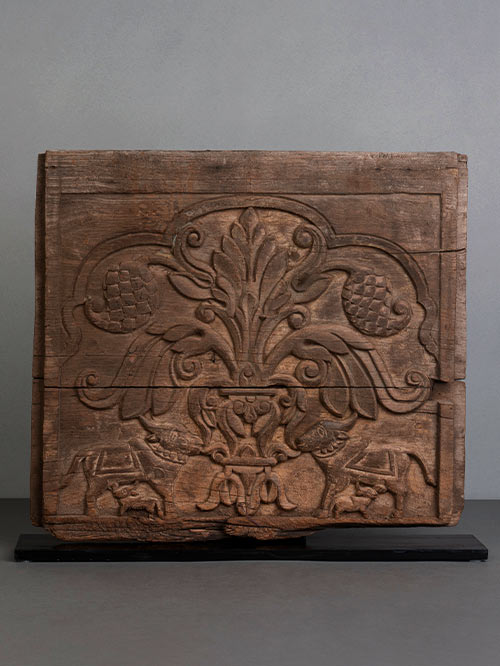
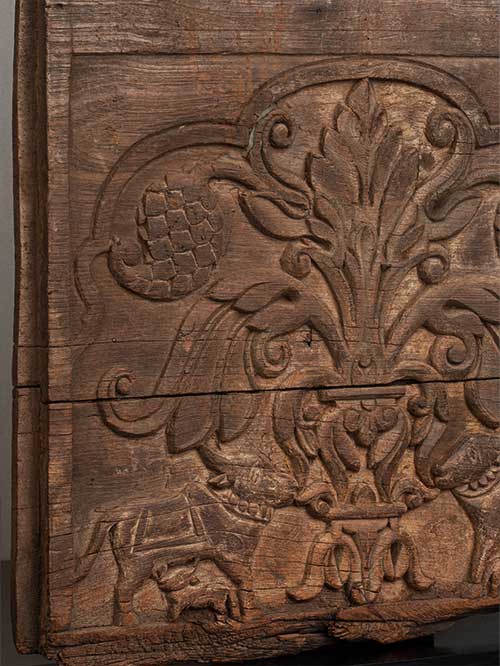
Deccan
Wood
This exemplary carved panel is delicately adorned with a central floral sprig, from which two custard apples (sitaphal) gracefully sprout. Beneath them, a pair of domesticated bulls graze on the low-hanging leaves, while a pair of diminutive calves suckle at their teats. The scene is enclosed within a trefoil archway.
Wooden construction was once widespread throughout most of Southern India, but the intense heat and the severe monsoonal rains have meant that a large proportion of the wooden buildings in private and public use have now disappeared. The typical southern Indian wooden building, was supported on a framework of columns, with an elaborate system of interlocking brackets and beams to support the floors and roofs. Carved doors, windows, and screens and panels filter light and ventilate the interiors, creating an environment that is both comfortable and richly detailed. The scale and shape of houses was dictated by the maximum height and span of timber beams, resulting in a modular system of construction. The woodwork was deeply cut and naturalistic, the intention of the artisans was to capture the forms and energies of the natural world. Panels such as these, with floral medallions radiating in full bloom or others with elaborate geometric modelling, ornamented of palaces, houses and temples.
Size (cms): 43(H) x 51(W) x 9(D)
Size (inches): 17(H) x 20(W) x 3.5(D)
-
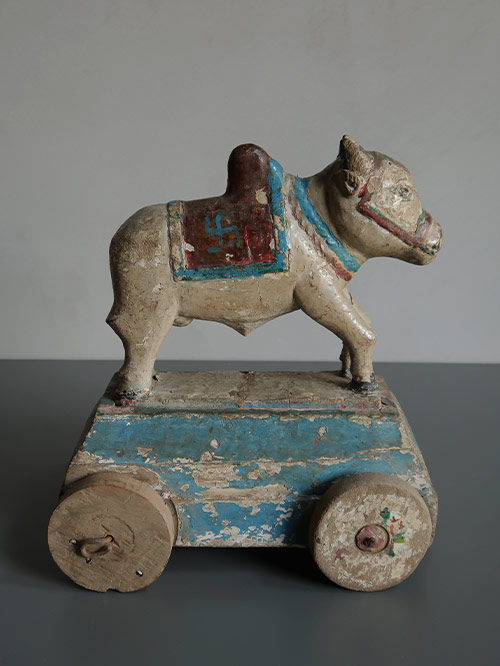
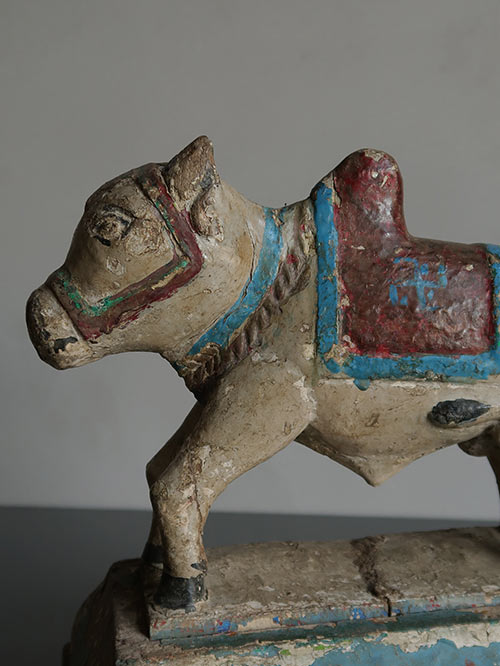
Maharashtra/Karnataka
Wood, polychromed
A decorative Nandi painted with patterns symbolising typical trappings including a saddle and head and neck ornaments. A right-facing swastik is painted on the saddle, symbolizing the sun, prosperity and good luck. The Nandi stands on a pedestal with wheels. Animal festival toys are used for ritual display and celebration during important festivities such as Pola, Holi, Shivaratri and Durga Puja.
Nandi festival toys have a special importance during the festival of Pola. Pola is an ancient thanks giving festival celebrated during the Hindu month of Sharavan during which farmers celebrate their cattle.
Nandi or Nandin means rejoicing, gladdening. It is the name of Shiva’s conveyance (vahana) the white bull, son of Kashyapa and of Surabhi. Nandi was probably a folk deity later incorporated into the Brahmanic lore. Nandi symbolises on the one hand moral and religious duty (dharma), and on the other, virility, fertility and strength. Apart from being Shiva’s vehicle, nandi in his form as nandikeshvara, depicted as a human with a bulls head, is believed to be one of the great masters of music and dancing. In southern India his recumbent image is placed either opposite the main sanctuary or in the hall leading to it, facing the linga.
Size (cms): 33.5(H) x 30(W) x 20(D)
Size (inches): 13(H) x 12(W) x 8(D)
-
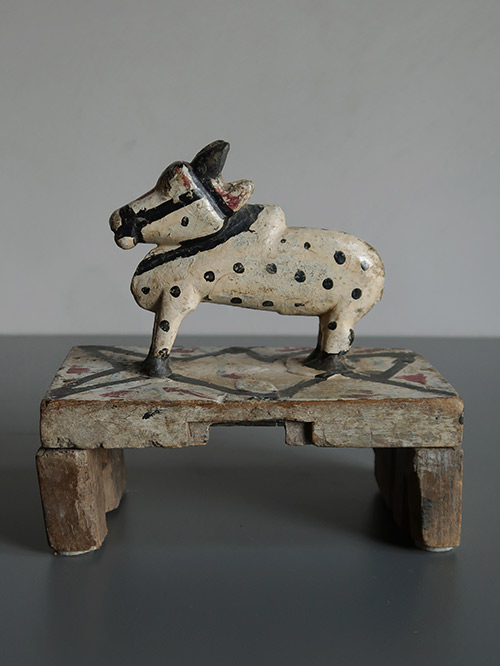
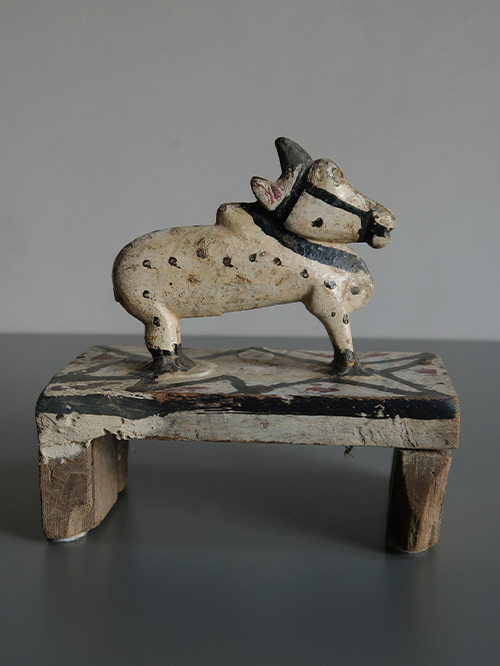
Maharashtra/Karnataka
Wood, polychromed
A decorative Nandi painted in white with black dots and typical trappings including a bridle bit. The Nandi stands on a pedestal painted with a geometric star. Animal festival toys are used for ritual display and celebration during important festivities such as Pola, Holi, Shivaratri and Durga Puja.
Nandi festival toys have a special importance during the festival of Pola. Pola is an ancient thanks giving festival celebrated during the Hindu month of Sharavan during which farmers celebrate their cattle.
Nandi or Nandin means rejoicing, gladdening. It is the name of Shiva’s conveyance (vahana) the white bull, son of Kashyapa and of Surabhi. Nandi was probably a folk deity later incorporated into the Brahmanic lore. Nandi symbolises on the one hand moral and religious duty (dharma), and on the other, virility, fertility and strength. Apart from being Shiva’s vehicle, nandi in his form as nandikeshvara, depicted as a human with a bulls head, is believed to be one of the great masters of music and dancing. In southern India his recumbent image is placed either opposite the main sanctuary or in the hall leading to it, facing the linga.
Size (cms): 21(H) x 20(W) x 12(D)
Size (inches): 8.5(H) x 8(W) x 4.5(D)
-
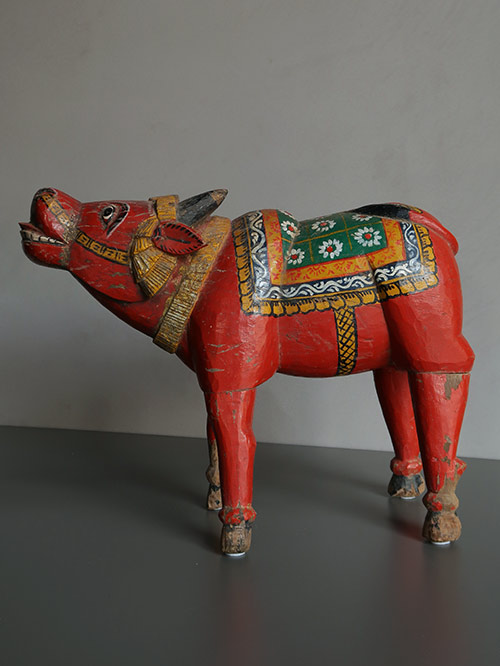
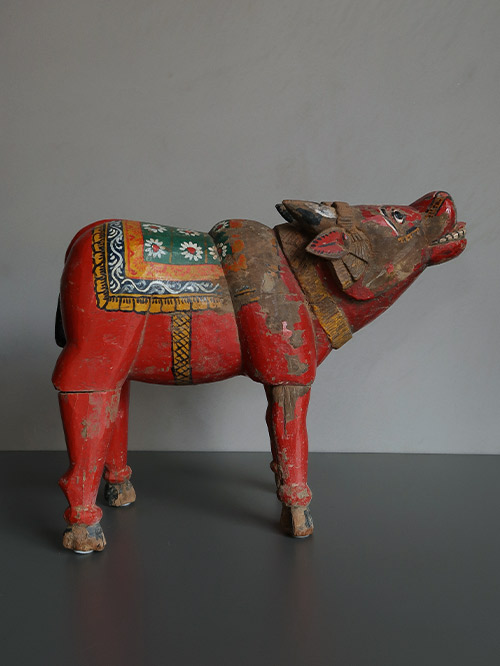
Coastal Karnataka (Bhuta culture)
Wood, polychromed
A large painted wood figure of a standing nandi. Displaying the typical folk bhuta style of coastal Karnataka, this figure is painted predominantly in red with a floral painted saddlecloth and a curled back tail resting on its back.
The bhuta tradition is popular on the Malabar coast. Bounded by the dramatic sweep of the forested ghats to the east and the Arabian sea to the west, and encircled by rivers, the South Kanara district of coastal Karnataka has enjoyed relative geographic isolation until recent years. The totemic origin of this bull bhuta is quite obvious in a land of agriculture and farms where ploughs are pulled by bulls and where cow milk is one of the main sources of protein. The link with Hinduism is also easily established through Nandi the vahana (“vehicle”) of god Shiva.
Size (cms): 36(H) x 46(W) x 16(D)
Size (inches): 14(H) x 18(W) x 6.5(D)
-
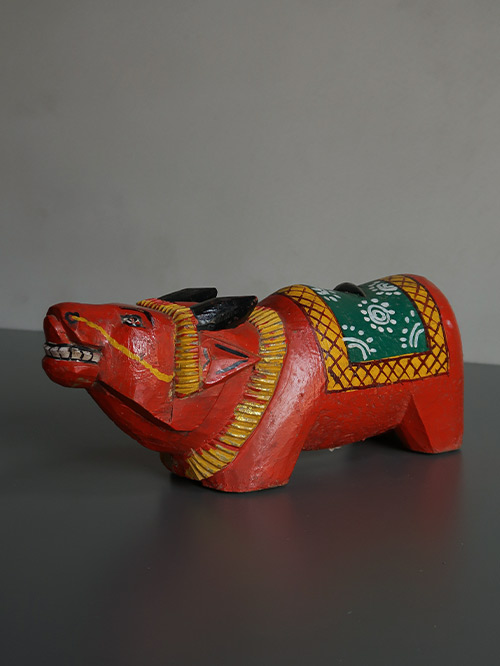
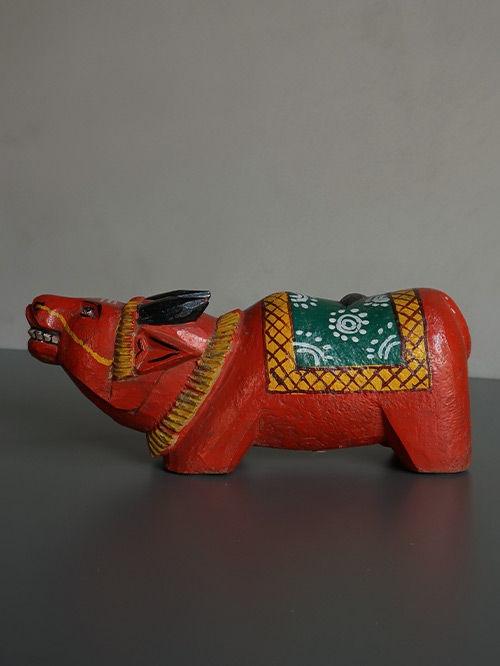
Coastal Karnataka (Bhuta culture)
Wood, polychromed
A fine painted wood figure of a standing nandi. Displaying the typical folk bhuta style of coastal Karnataka, this figure is painted predominantly in red It displays a typical stylised form with a horizontal head with slightly protruding tongue, horns adorned with ornaments, a floral painted saddlecloth and a curled back tail resting on its back.
The bhuta tradition is popular on the Malabar coast. Bounded by the dramatic sweep of the forested ghats to the east and the Arabian sea to the west, and encircled by rivers, the South Kanara district of coastal Karnataka has enjoyed relative geographic isolation until recent years. The totemic origin of this bull bhuta is quite obvious in a land of agriculture and farms where ploughs are pulled by bulls and where cow milk is one of the main sources of protein. The link with Hinduism is also easily established through Nandi the vahana (“vehicle”) of god Shiva.
Size (cms): 14(H) x 35.5(W) x 11(D)
Size (inches): 5.5(H) x 14(W) x 4.5(D)
-

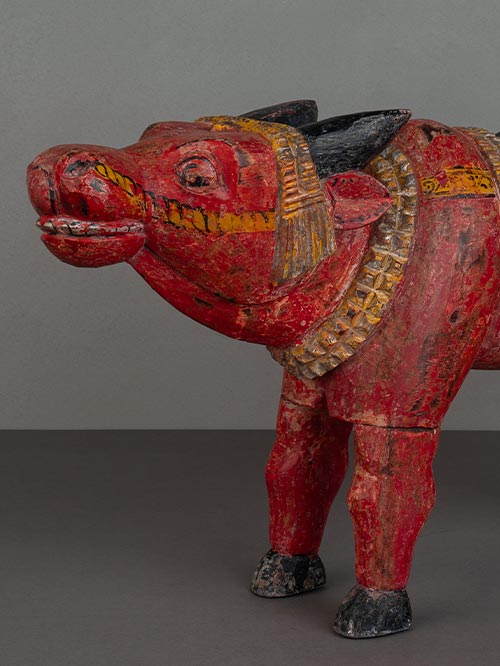
Coastal Karnataka (Bhuta culture)
Wood, polychromed
A fine painted wood figure of a standing nandi. Displaying the typical folk bhuta style of coastal Karnataka, this figure is painted predominantly in red with a painted saddlecloth and a curled back tail resting on its back.
The bhuta tradition is popular on the Malabar coast. Bounded by the dramatic sweep of the forested ghats to the east and the Arabian sea to the west, and encircled by rivers, the South Kanara district of coastal Karnataka has enjoyed relative geographic isolation until recent years. The totemic origin of this bull bhuta is quite obvious in a land of agriculture and farms where ploughs are pulled by bulls and where cow milk is one of the main sources of protein. The link with Hinduism is also easily established through Nandi the vahana (“vehicle”) of god Shiva.
Size (cms): 32(H) x 52(W) x 14(D)
Size (inches): 12.5(H) x 20.5(W) x 5.5(D)
-
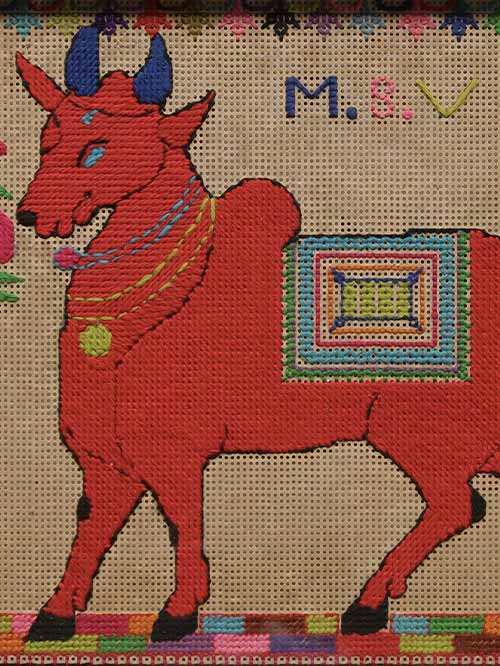
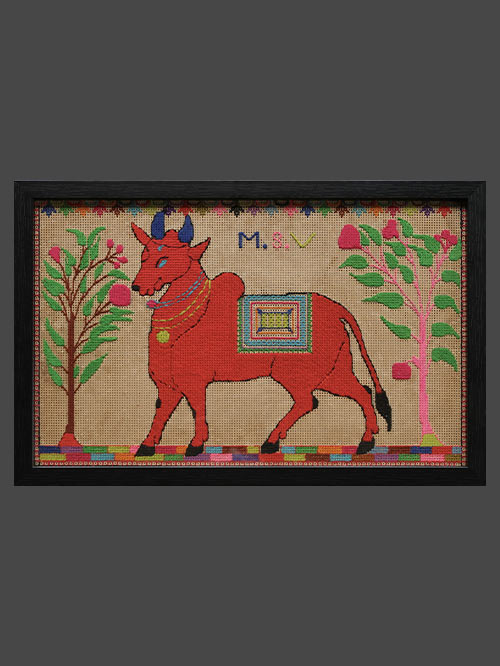
Chettinad (Tamil Nadu)
cross stitch embroidery
This whimsical cross stitch embroidery artwork depicts a bright orange caparisoned Nandi with blue horns stands facing left between two trees.
Framed Size (cms): 32(H) x 49(W)
Framed Size (inches): 12.5(H) x 19.5(W)
-
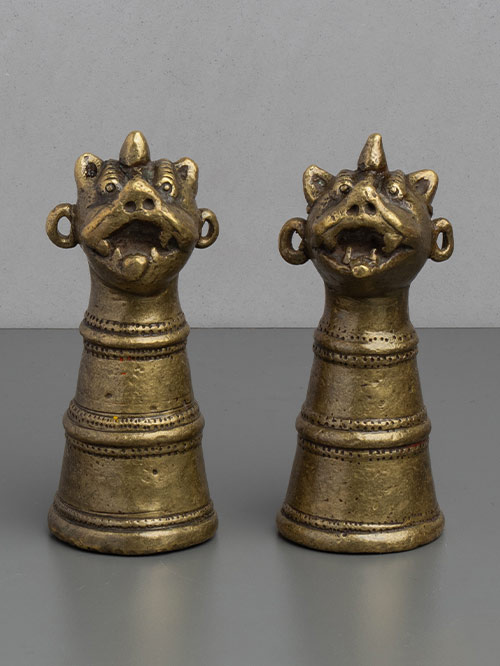

Karnataka
Brass
A decorative pair of horn cap ornaments with vyali (lion) finials. They would have been fixed to nandi (bull) horn ends as a decorations for the Pola festival, during which draft animals are thanked for their help in plowing the fields.
Nandi or nandin, the bull vahana of Shiva has always been noted for his strength and virility. Usually depicted in a life-like naturalistic manner, Nandi is present in every Shaivite temple, often with his own temple enclosure but facing the Shiva lingam. Figures like this of Nandi on a platform base with a cobra canopy are common objects of worship, especially found in home shrines.
Indiv. Sizes (cms): 12(H) x 5(W) x 5(D) each
Indiv. Sizes (inches): 4.5(H) x 2(W) x 2(D) each
-


Karnataka (South India)
brass alloy
This gracefully proportioned standing Nandi is delicately incised with head and neck ornaments and stands on a trapezoidal base.
Nandi or nandin, the bull vahana of Shiva has always been noted for his strength and virility. Usually depicted in a life-like naturalistic manner, Nandi is present in every Shaivite temple, often with his own temple enclosure but facing the Shiva lingam. Figures like this of Nandi on a platform base with a cobra canopy are common objects of worship, especially found in home shrines.
Size (cms): 16.5(H) x 10.8(W) x 7.6(D)
Size (inches): 6.5(H) x 4.5(W) x 3(D)
-
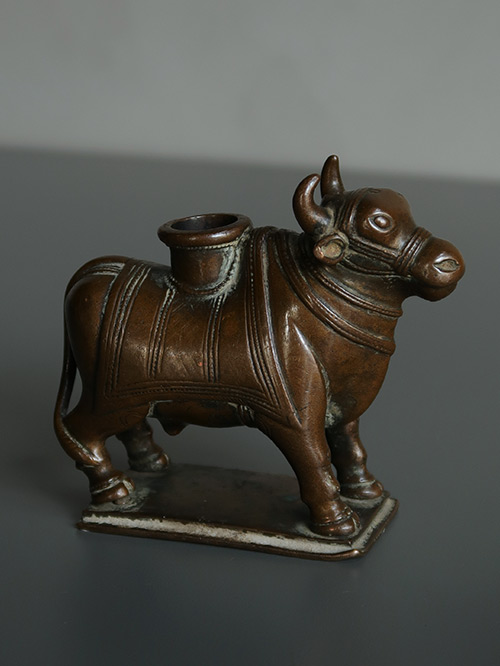

Karnataka (South India)
copper alloy
A beautifully caparisoned copper Nandi standing on a rectangular plinth. The Nandi wears an engraved saddle blanket which is surmounted by a bowl-like structure which would have held an incense burner or an oil reservoir. He is bridled and decorated with necklaces around his neck.
Nandi or nandin means rejoicing, gladdening. It is the name of Shiva’s conveyance (vahana) the white bull. Nandi was probably a folk deity later incorporated into the Brahmanic lore. Nandi symbolises on the one hand moral and religious duty (dharma), and on the other, virility, fertility and strength. Apart from being Shiva’s vehicle, nandi in his form as nandikeshvara, depicted as a human with a bulls head, is believed to be one of the great masters of music and dancing. In southern India his recumbent image is placed either opposite the main sanctuary or in the hall leading to it, facing the linga.
Size (cms): 10.8(H) x 11.5(W) x 4.7(D)
Size (inches): 4.5(H) x 4.5(W) x 2(D)
-
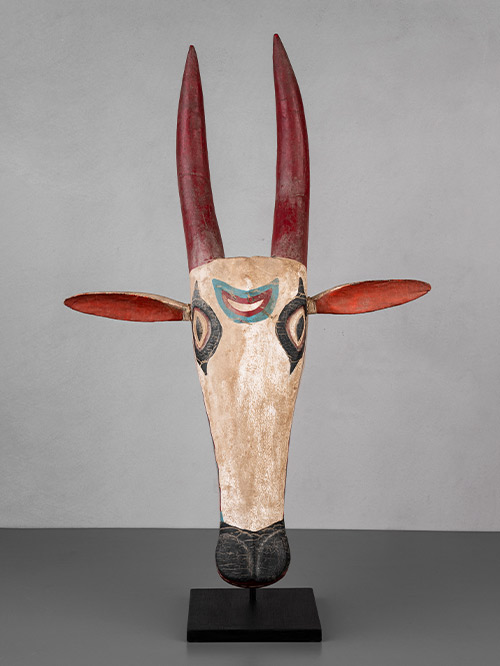
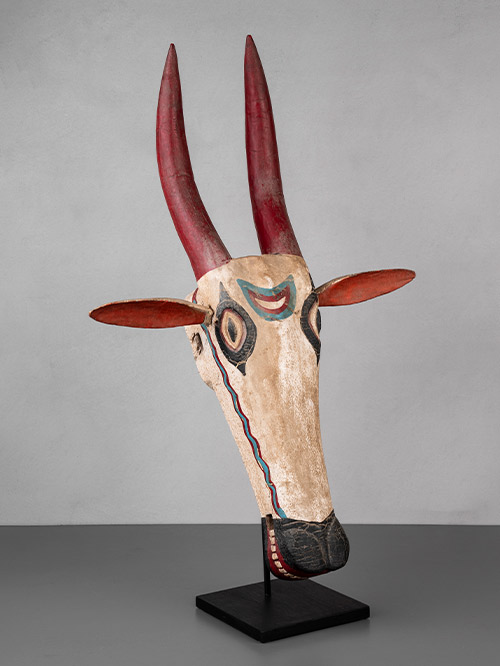
Kerala
Wood, polychromed
A finely painted Nandi festival head.
These heads are used in bull festivals known as kala velas. Bull festivals originated out of people’s desire to keep their bulls, bullocks and oxen healthy as they were used for ploughing and other work. In a society whose well-being was linked to good and bountiful crops and who therefore sought the benevolence of nature, these animals played a major role. The idea was to make an offering of them to their local deity- Bhagavathi. Their importance can be realised by the fact that at Mulayankavu there are forty pairs of these effigies at both the main festival in the Malayalam month of Medam (mid-April to mid-May) and their other festival in Meenam (mid-March to mid-April). The difference is that in Meenam there are also eleven single bullocks belonging to particular families in the area. These festivals are exclusive to the region of northern Kerala known as Valluvanad, formerly a small kingdom.
Mask Size (cms): 86.5(H) x 59(W) x 14(D), 92.5 (H with stand)
Mask Size (inches): 34(H) x 23(W) x 5.5(D), 36.5 (H with stand)
-
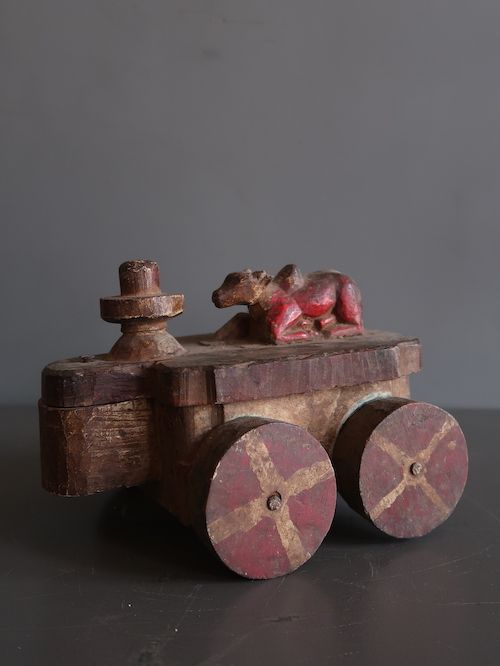
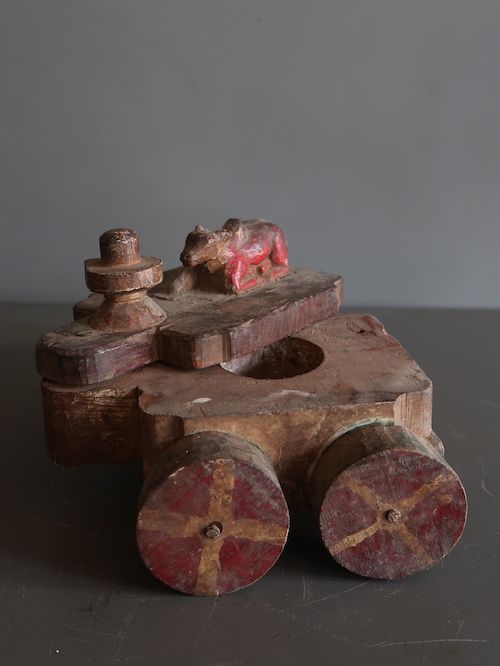
Karnataka (South India)
Wood, polychromed
A rare ash box on wheels with a carved figure of a nandi and a lingam on top. It was used to store Vibhuti. Also referred to as Bhasma (holy ash), Vibhuti is of great significance in Hinduism and especially in Shaivism where it is thought to symbolise the mystic power of Lord Shiva.
Size(cms): 16 (H) x 21.5 (W) x 19 (D)
Size(inches): 6.2 (H) x 8.5 (W) x 7.5 (D)

























